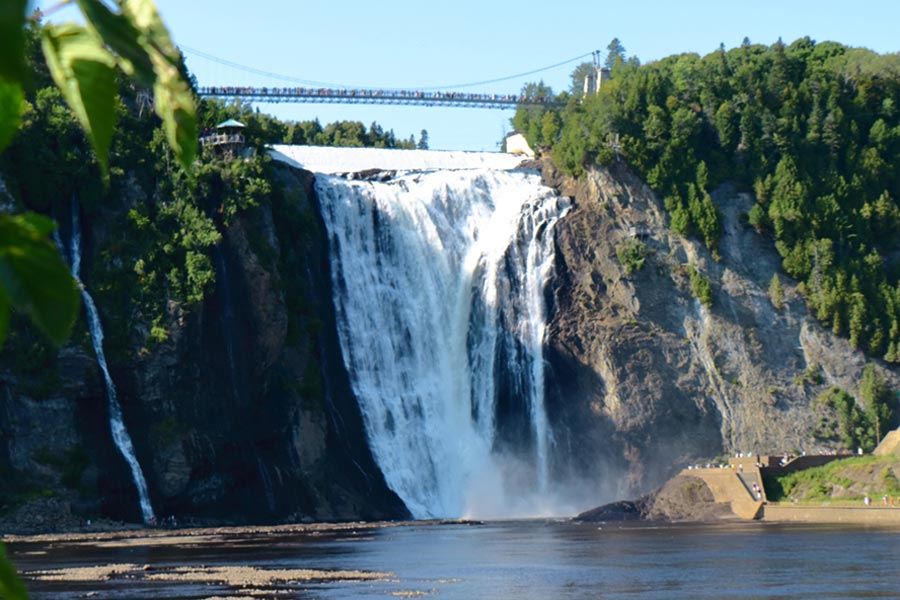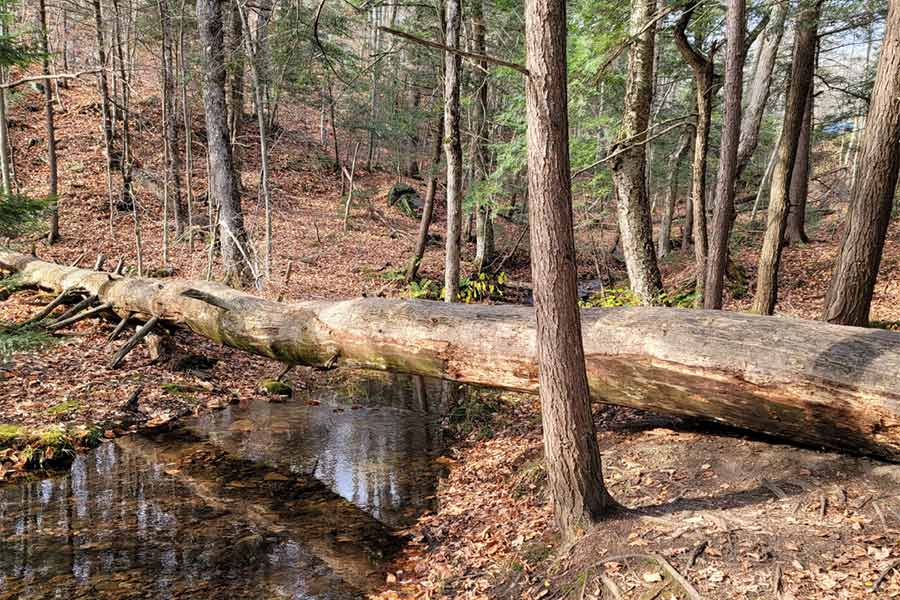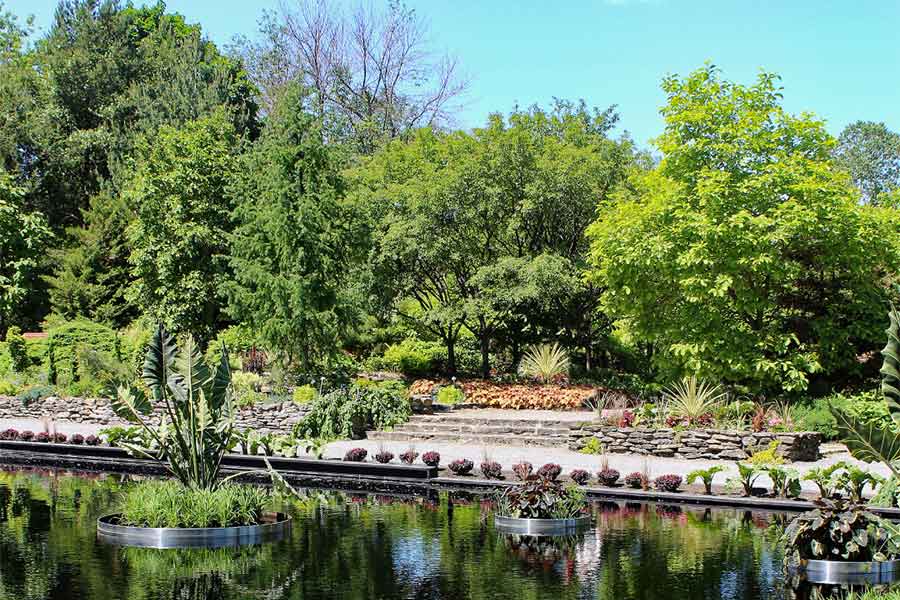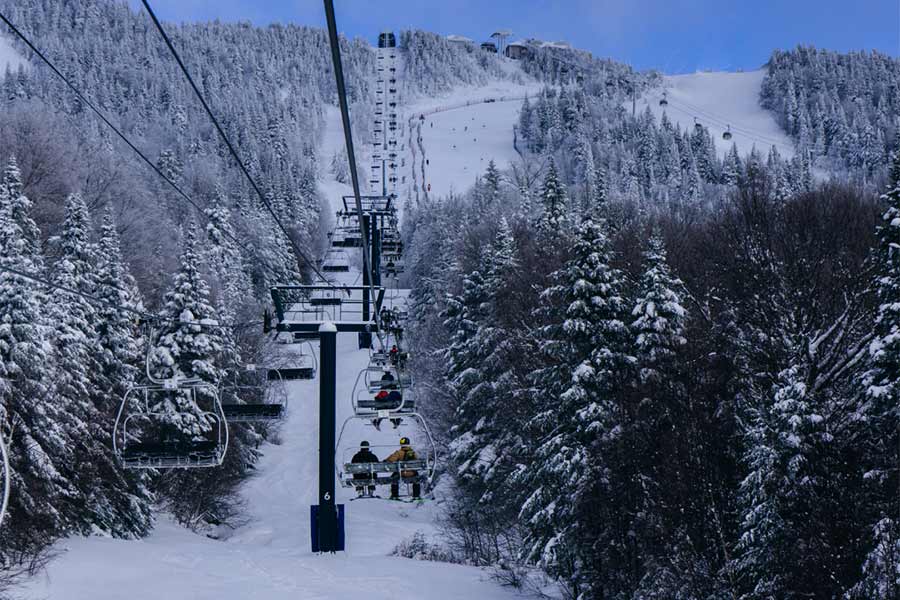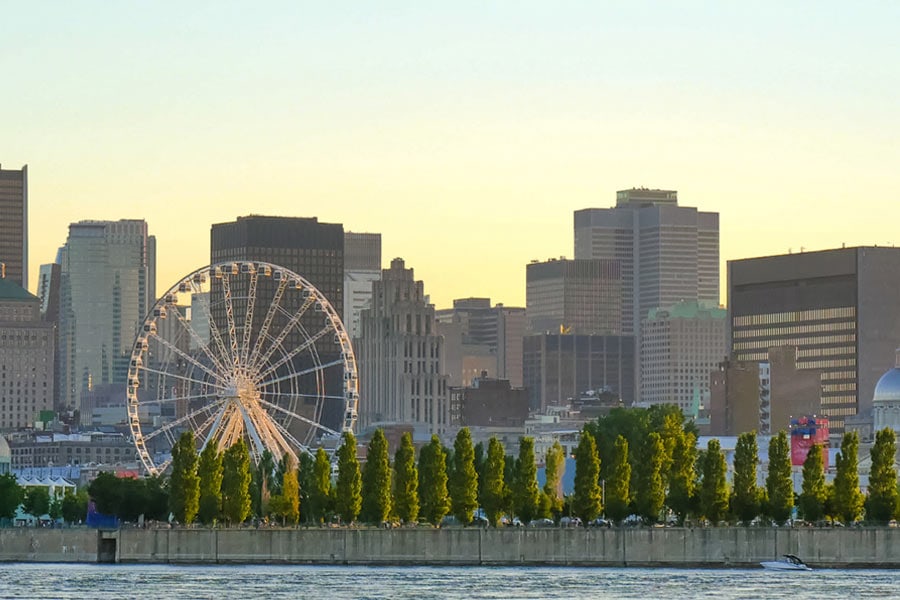Bonjour, Quebec! Canada's largest province and home to four of the oldest cities in the country is a beauty to explore. From Old Montreal's walled city to the Gatineau Hills, Quebec is a feast for the eyes.
The province that spans over 1.5 million kilometres has a lot to offer. Northern tundras, vibrant cities, sunny beaches, and some of the best ski resorts share this one magical region. How could you possibly discover everything in one trip?
Well, buckle up! Because we're about to share the top five tourist destinations in Quebec.
Dichotomy of Quebec
Quebec is one of the most diverse locations in Canada. A true mosaic of ecosystems and landscapes. It's also home to six ecozones:
- Northern Arctic
- Southern Arctic
- Taiga Shield
- Hudson Plains
- Boreal Shield
- Mixedwood Plains
If you drove through in one day, you'd experience vastly different weather, flora, and fauna. Ice and snow cover Quebec's far north as polar bears, musk ox, tundra wolves, and caribou roam. It's also the site of three immense national parks.
The Southern Arctic is not much warmer, only hitting about 5ºC in the summer. Bears, wolves, foxes, and hares live off the land and moss, lichen, and small shrubs decorate it.
The Taiga Shield is a flat terrain dotted with glacier depressions that have transformed into bodies of water. Cool, short summers and long, freezing winters characterize the climate. Many birds migrate through the region, and small mammals make their home here.
Wetlands best describe the Hudson Plains. Spruce, Balsam, and Poplar form the forests, and Canadian geese, moose, and bears are often spotted. The Boreal Shield enjoys a continental climate and thousands of freshwater bodies of water.
The St. Lawrence River cuts through the Mixedwood Plains. It's a fertile ecozone known for its rich soil, vegetation, and mild climate. Although deer, squirrels, and foxes call it home, many humans do as well. As populations grow, the natural habitats and animals recede.
History of Quebec
Founded in 1608 by Samuel de Champlain, Quebec's growth was slow until the mid-19th century. When trade routes became more important, its position on the St. Lawrence River turned Quebec into a prominent port town. It was one of the founding members of Canada on July 1, 1867.
The Catholic Church dominated many aspects of life for French-speaking Quebeckers in the decades following 1867. The Church was in charge of many of the institutions of the province, including most French-language schools, hospitals, and charities.
More recently, between the 1960s and 1970s Quebec was greatly affected by the baby boom. More young Quebeckers rejected the Catholic teachings that were dominant for so long. It was during this time that the Quebecois developed their own identities, embracing arts and culture.
In the late 1960's Quebec nationalism quickly became Quebec separatism. The fight for Quebec to separate from Canada grew while French and English speakers were divided. The 1995 referendum deemed that Quebec would remain a part of Canada. To this day, there are many people and politicians who still believe in separatism and see Quebec as it's own nation.
Though today, the city of Montreal is very much bilingual, having several major English and French universities in the city centre. The city prides itself on the Quebecois culture which basks in art, music, theatre, and fine foods.
Getting Around Quebec
Since Quebec is Canada's largest province, the best way to explore is by car. Rent a vehicle or use your own to discover small towns, thriving cities, and stunning scenic landscapes. Just make sure you have comprehensive car insurance!
Location
Quebec covers a large portion of Canada's east coast, stretching from Ontario in the west to Newfoundland and Labrador in the east. Northern Quebec opens up into Hudson's Bay, and the southern side borders the United States.
Transportation
If you're driving, you'll enjoy 325,000 kilometres of open road! The province boasts 30 highways and over 200 secondary roads. You can also criss-cross parts of Quebec by coach bus, but only certain towns are on the network.
Large cities like Montreal and Quebec City are easy to navigate by bus and subway. You can also satisfy your inner explorer by heading to Quebec's far north! Hop on a flight to Ivujivik, one of the most Northern towns in the province and keep an eye out for polar bears.
1. Montmorency Falls
Montmorency Falls towers at 83 metres, dropping into the St. Lawrence River below. That's a full 30 metres loftier than another well-known Canadian gem, Niagara Falls.
You can find this stunning waterfall in Montmorency Falls Park, a short 12 kilometres away from Old Quebec City. There are many ways to get there, including by car, bus, and guided tours. There's even a bike path that goes all the way to the park!
The best time to visit is in the summer when lush green foliage and sunny days create an unmissable experience. All facilities are open during the summer months, so you'll get the most bang for your buck.
We recommend taking the cable car up to the top to admire the breathtaking views of Montmorency Falls. At the top, visit the interpretation centre at the Manor and grab a bite to eat. Then it's time to hike!
The footpaths guide you throughout the park and are easy to follow. Stop off at the suspended bridge for the best photo-ops. More adventurous travellers can explore the cliffs through the "via Ferrata" routes.
These assisted climbing routes are led by guides and work for daredevils of all ages. Make your way down using the Montmorency Falls Zipline for a rush of adrenaline.
Montmorency Falls Zipline
Get strapped in and jump! You'll feel like you're flying as you soar 300 metres over the cove. Hear the waterfalls thunder as you zip past. Feel the splash and mist of the cool water on your face. Scream your heart out as you jet through the air!
There is a weight limit that ranges between 40 and 100 kg. In the event of bad weather, weight limits are adjusted down, so aim to get there on a nice, sunny day.
2. Gatineau Park
This massive 361 kilometre-squared park rests on the shores of the Ottawa River. It's accessible from Ottawa and Gatineau, and the park areas closest get very busy on weekends.
Gatineau Park is open year-round and offers enjoyable activities every season. Visit in the winter when the rolling hills are covered in shimmering snow and enjoy:
- Winter hiking
- Cross-country skiing
- Snowshoeing
- Snow biking
- Winter camping
- Ice climbing
Or head to the park in the heat of summer to cool off in one of the many lakes. You can also try your hand at:
- Fishing
- Boating
- Hiking
- Camping
- Rock climbing
- Horseback riding
Families, friends, and couples will love the park's many picnic spots. Eight of the picnic areas feature barbecues for guests to use. Or head over to one of the stunning beaches for a sandy picnic!
Gatineau Park Trails
Gatineau Park has a wealth of trails to explore. But if you plan a visit in the winter, you'll only have access to eleven of them. We recommend the Sugarbush trail, a beginner-level 3-kilometre hike through a peaceful forest.
Families will enjoy the Pioneer's Walk, an interpretative trail they can finish in under 30 minutes. Discover the history of the Outaouais settlers as you stroll through. This trail is fully accessible and allows dogs on leashes.
Gatineau Park Ski Conditions
Cross-country skiing at Gatineau Park is a quintessential Quebec winter experience. Explore a few of the 50 expertly groomed trails. You'll see enormous hemlocks, thick forests of pine, and maybe even some wildlife! Ski conditions are updated twice a day on the park's website.
3. Montreal Botanical Gardens
Located in Montreal, this sprawling garden is the perfect place for education and exploration. Families can spend all day covering the enormous 75-hectare grounds featuring thematic gardens, greenhouses, and cultural gardens.
The Montreal Botanical Gardens houses over 10,000 species of plants. July and August are perfect months to view the biggest, brightest blooms. Or book your trip in October when the gardens hold their annual Gardens of Light festival.
Stroll through the Chinese garden and marvel at hundreds of silk-covered lanterns. Immerse yourself in the multimedia experience at the First Nations garden. Then end your evening with a meditative walk through the Japanese gardens.
While you're in the area, don't forget to visit the Biodome, Insectarium, and Planetarium. You can also stop by Olympic Park and take the kids to the truly awesome Vans Skatepark!
4. Mont Tremblant
This world-famous ski village is just over an hour away from Montreal and two hours from Ottawa. Visitors can drive, take an airport shuttle bus, or catch a coach bus from Montreal. To make things simple, take a direct flight from Toronto to Mont Tremblant on Porter Airlines.
You'll find 102 ski trails on Mont Tremblant, ranging from beginner to expert. Featuring four slopes, 875 metres height, and 14 lifts, you won't get bored for a single second! Those just starting out can take lessons at Tremblant's Snow School.
But skiing isn't the only pastime in the village. Enjoy a range of activities for the whole family, including:
- Dogsledding
- Snowshoeing
- Snow biking
- Cross-country skiing
- Hiking
- Alpine touring
- Ice fishing
- Snowboarding
Then spend the rest of the day exploring the quaint, European-style village. Shop till you drop at more than 34 village shops. Pause for a BeaverTail break and enjoy this fried pastry topped with brown sugar, chocolate, Oreo crumbles, and tons of other toppings!
Kids will love strolling through the streets in search of Toufou, Mont Tremblant's beloved mascot. And a chance meeting with Marc-Ambulles will delight children of all ages. The iconic street performer crosses the village streets, passing out balloon animals.
The village offers 37 restaurants, cafes, and lounges. Start the day off at La Maison de la Crêpe, a cozy homestyle restaurant offering a comforting breakfast.
Grab a quick lunch at Cheesus and relive a bit of childhood nostalgia with a grilled cheese sandwich. Enjoy a rustic dinner at Le Q.G, where local flavours and hand-mixed cocktails reign supreme.
Mont Tremblant Hotels
You'll find everything from luxury retreats to budget hotels and rental condos available at Mont Tremblant. With 28 options located in the area, there's a perfect home base for everyone.
For luxury stays, you can't beat the Fairmont Tremblant. This 4-star hotel offers 314 rooms, suites, and apartments for its guests. Hôtel Quintessence and Le Westin Resort & Spa are two other luxe stays on the mountain.
Auberge Manitonga is a stylish, highly-rated hostel in the heart of the village at budget prices. For a rustic, old-world experience at a low cost, look into Hotel Mont-Tremblant.
Mont Tremblant Weather
Mont Tremblant offers perfect, ski-worthy winter days from December to March. Temperatures rarely go below -5°C, and rain is uncommon.
The summer season is warm enough to swim and enjoy the beaches. Running from May until the beginning of September, the temperatures hover in the mid-20s. The weather is just one of the amazing reasons to plan a summer visit.
5. Parc Jean Drapeau
On an island in the St. Lawrence River, in the centre of Montreal, sits the breathtaking Parc Jean Drapeau. Once the home to the 1967 World's Fair, this scenic location is now the perfect place for picnics and outdoor activities.
The quickest way to get there from downtown Montreal is by subway. Just hop off at Jean-Drapeau station, and you'll find yourself in the centre of the park! You can also walk, ride a bike, drive, or hail a taxi.
Parc Jean Drapeau is an all-season destination with tons of activities and events. In the winter, you can enjoy:
- Ice skating trail
- Sliding down the many hills
- Snowshoeing and hiking
- Cross-country skiing
- Fat biking
But summer is the park's time to shine! Lounge on Jean-Dore Beach and relish swimming in the cool water. Rent a kayak or a canoe to explore the island. Or sign up for stand-up paddleboard lessons if you want to learn a new skill.
Other warm-weather activities you can enjoy around the park include:
- Floralies Gardens
- Public art trails
- Swimming at the Aquatic Complex
- Picnics
- Bike routes
- Rock climbing
- Rowing
- Dragon boats
- La Ronde Amusement Park
The island also hosts many cultural events and music festivals. The two largest are Osheaga and Île Soniq. Arts and music lovers flock to the island each summer for Osheaga's three-day festival. Showstopping performances include international and Canadian artists.
Meanwhile, electro-music fans dance their hearts out at Île Soniq! This summer dance party happens annually on the island as 50+ musical acts show up to entertain.
Pack Your Bags and Head to Quebec Today!
If you've never visited this French-speaking destination within Canada, now is the time! Even if it's not your first time, our list of the top five tourist destinations in Quebec is a must-see.
Before you set off on your trip, we recommend picking up some travel insurance. Travel insurance is always a good idea, even if you're exploring your own country!
Get your free insurance quote from Insurdinary today and start planning your next vacation.


